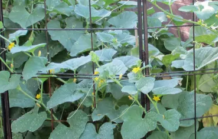Although carpenter bees look much like bumblebees, they are easy to identify if you know what to look for. Bumblebees have hairy abdomens that are usually yellow and black. Carpenter bees’ abdomens are shiny blue-black. Carpenter bees are solitary (do not form colonies) and are nonaggressive unless provoked. Only the female possesses a stinger. The male may act aggressive but is harmless. Carpenter bees get their name from the ability of the female to bore into wood. Holes are about a half-inch in diameter and may be 6 inches deep. The female then builds six to eight cells off the main tunnel and lays an egg in each. Developing larvae feed off of “bee bread” (pollen and nectar) regurgitated by the female bee. Larvae become adults by late August and September, but do not emerge until the following spring. Individual holes may not cause much damage, but cumulative effects of numbers of bees can weaken structures. Painting wood surfaces can make them less attractive to bees. Stains seem to have little effect. Insecticides, such as Sevin, can be used to treat openings. Sprays and dusts are both effective but sprays may only last for 1 to 2 weeks and require retreatment. Dusts are most easily applied with a puffer duster. It is best to treat near sundown when the bees have returned to their tunnel. (Ward Upham)




